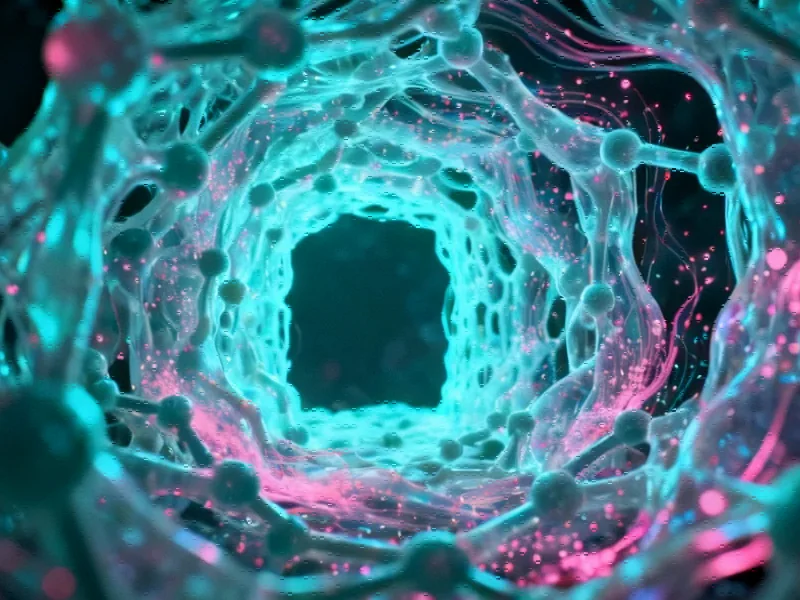Cellular Traffic Control Mystery Solved
An international team of researchers has reportedly cracked one of biology’s longest-standing puzzles: how cells precisely control the flow of materials between the nucleus and cytoplasm. According to reports published in the Proceedings of the National Academy of Sciences, scientists have created the most comprehensive model to date explaining the sophisticated molecular machinery governing this essential cellular process.
The research collaboration involved scientists from multiple institutions including the Hebrew University of Jerusalem, UCSF’s Quantitative Biosciences Institute, The Rockefeller University, and Albert Einstein College of Medicine. Their work focuses on nuclear pore complexes (NPCs), which function as molecular gatekeepers between the cell nucleus and cytoplasm.
The Sophisticated Cellular Checkpoint
Sources indicate that NPCs operate with remarkable efficiency despite their minuscule size. “Think of NPCs as tiny yet highly sophisticated security checkpoints,” explained Dr. Barak Raveh of Hebrew University, the study’s lead author. “Even though each one is only about one five-hundredth the width of a human hair, it lets millions of molecules meant for transport pass per minute while screening out the rest.”
For decades, analysts suggest scientists have struggled to understand how these molecular gates could maintain both speed and selectivity. The new computational model reportedly integrates years of fragmented experimental data into a single framework that captures molecular-level events occurring in thousandths of seconds.
Breaking with Traditional Models
Earlier conceptions of NPC function envisioned them as mechanical gates or cohesive hydrogels with fixed pore sizes. However, the report states these models failed to explain the observed speed, adaptability, and reversibility of nucleocytoplasmic transport, particularly the rapid passage of large molecular assemblies.
Instead, the research team has identified ten molecular design features that work in concert to ensure the NPC’s extraordinary performance. Central to this new understanding is the concept of an entropic barrier, where entropy – a measure of molecular disorder – plays a crucial role.
The Dynamic Molecular Dance
According to the model, the pore interior forms a dense, dynamic “forest” of flexible protein chains called FG repeats. Rather than functioning as a single channel, fleeting openings continually appear and disappear in this highly dynamic thicket, permitting small molecules to diffuse while statistically discouraging larger ones.
“Because these FG repeat chains are always in motion and take up space, they create a crowded, restless environment,” said Professor Michael Rout of The Rockefeller University. “The transport mechanism can be imagined as a vast, ever-shifting dance across a bridge.”
Large molecular cargoes reportedly gain passage when accompanied by nuclear transport receptors – specialized molecular “passports” that overcome the entropic barrier by making numerous fast, transient “handshakes” with the FG chains. This system bears no relation to non-player character mechanics in gaming, but represents a sophisticated biological process refined by evolution.
Medical and Technological Implications
The findings have immediate significance for understanding diseases where nuclear transport malfunctions. “Our model provides the first quantitative, reductionist, and mechanistic explanation for how the NPC achieves this remarkable selectivity,” said Professor Andrej Sali of UCSF. “This understanding opens new possibilities for therapeutic interventions and biotechnology applications.”
Professor David Cowburn of Albert Einstein College of Medicine added that the research has “immediate implications for understanding diseases including ALS, Alzheimer’s disease, and cancers.” The model could also serve as a blueprint for designing artificial nanopores that might revolutionize biotechnology applications.
This breakthrough comes amid broader industry developments in biological research and follows related innovations in molecular science. The computational approach demonstrates how recent technology advances are enabling new discoveries, similar to market trends in other scientific fields and related innovations across technology sectors.
A Milestone in Structural Biology
The computational model has reportedly been validated against multiple independent datasets and accurately predicted previously unobserved transport behaviors. Analysis suggests the system’s redundancy and exponential sensitivity make it both robust and finely tunable, a feature that likely explains its evolutionary resilience.
This achievement marks a significant milestone in integrative structural biology, demonstrating how computational modeling can unify diverse experimental findings into a coherent understanding of life’s molecular machinery. The research provides a foundation for future investigations into cellular transport mechanisms and their role in health and disease.
This article aggregates information from publicly available sources. All trademarks and copyrights belong to their respective owners.
Note: Featured image is for illustrative purposes only and does not represent any specific product, service, or entity mentioned in this article.



